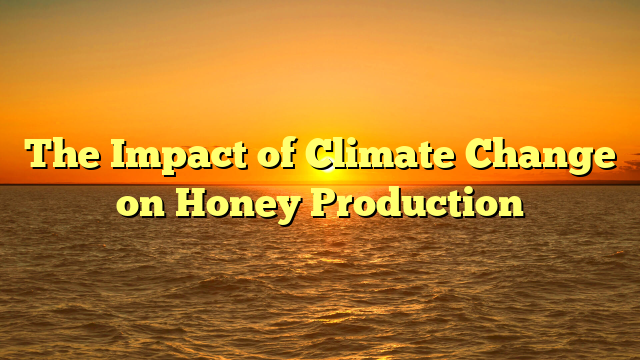
Bees play a vital role in maintaining ecosystems through pollination, and their production of honey is a critical component of agriculture and the global economy. However, climate change poses a growing threat to honey production and the health of bee populations worldwide. Rising temperatures, erratic weather patterns, and habitat loss are creating significant challenges for bees, beekeepers, and honey production.
How Climate Change Affects Bees
1. Temperature Fluctuations
Bees are highly sensitive to temperature changes, which can disrupt their foraging patterns and colony health. Warmer temperatures may lead to premature flowering of plants, causing a mismatch between when plants produce nectar and when bees are ready to forage. This mismatch reduces nectar availability, directly affecting honey production.
2. Extreme Weather Events
Increased occurrences of extreme weather, such as droughts, floods, and hurricanes, severely impact bee habitats. Droughts reduce the availability of flowering plants, while floods destroy hives and food sources. These events leave bees with fewer resources to produce honey and weaken their colonies.
3. 4d of Biodiversity
Climate change contributes to habitat loss and decreases in plant biodiversity. Bees rely on a variety of flowers for nectar and pollen. When certain plant species decline or disappear, bees lose vital food sources, which can lead to lower honey yields and poor nutrition for the colony.
4. Increased Pests and Diseases
Warmer climates foster the spread of pests and diseases that harm bee populations. For example, the Varroa mite thrives in higher temperatures, weakening colonies and reducing honey production. Additionally, climate change may exacerbate the spread of viruses and fungi that affect bees.
Impact on Honey Production
1. Lower Yields
Reduced nectar availability leads to lower honey yields. Beekeepers often report that their hives produce less honey during seasons with extreme weather or when plant diversity is compromised.
2. Changes in Honey Quality
The type and quality of honey depend on the flowers bees forage from. Climate change can alter the composition of nectar, affecting the flavor, color, and texture of honey. For instance, drought-stressed plants may produce nectar with less sugar content, resulting in honey that is less sweet.
3. Economic Challenges for Beekeepers
Beekeepers face increased costs as they work to mitigate the effects of climate change. Supplemental feeding, hive relocation, and pest control are necessary expenses that strain their livelihoods. Declining honey yields also impact their income, making it harder to sustain operations.
Efforts to Mitigate the Impact
1. Supporting Pollinator-Friendly Practices
Planting native flowering plants and reducing pesticide use can help create habitats where bees can thrive, even in changing climates.
2. Beekeeping Innovations
Beekeepers are adopting new strategies, such as hive insulation and monitoring systems, to protect colonies from extreme weather and pests.
3. Raising Awareness
Public education campaigns about the importance of bees and the threats they face are crucial for fostering support for conservation efforts.
The impact of climate change on honey production is a pressing concern for ecosystems, agriculture, and economies. Protecting bee populations requires collaborative efforts from governments, researchers, farmers, and individuals. By addressing the challenges posed by climate change, we can safeguard bees and ensure the sustainability of honey production for future generations.





